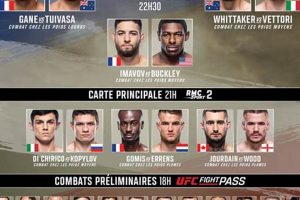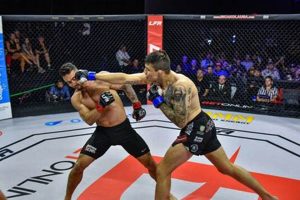In mixed martial arts, the ability to dictate where a fight takes place whether standing, in the clinch, or on the ground is a crucial determinant of success. A fighter who excels at imposing their preferred range and grappling scenario effectively neutralizes an opponent’s strengths and exploits their weaknesses. For instance, a wrestler might prioritize takedowns and ground control, while a striker aims to maintain distance and utilize superior stand-up skills. This strategic manipulation of fighting positions and engagement ranges is paramount for achieving victory.
Mastery of positional dominance provides a significant advantage, influencing judging criteria and impacting fight outcomes. It allows fighters to conserve energy, minimize damage, and create opportunities for offensive maneuvers. Historically, fighters like Georges St-Pierre and Khabib Nurmagomedov exemplified this principle, demonstrating how controlling the location and pace of a fight can lead to sustained success at the highest levels of competition. Their strategic approaches underscored the importance of dictating where the battle unfolds.
This understanding of positional dominance forms the foundation for a deeper exploration of specific techniques and strategies employed in MMA. Subsequent sections will delve into the nuances of takedown defense, clinch fighting, ground control, and striking from advantageous positions, providing a comprehensive analysis of how these elements contribute to overall fight strategy and success within the octagon.
Tips for Controlling Fight Positioning
Strategic positioning within the octagon is paramount for success in mixed martial arts. The following tips offer guidance on establishing and maintaining dominant fighting positions.
Tip 1: Takedown Mastery: Developing proficient takedown techniques, both offensive and defensive, is crucial. Offensive takedowns allow fighters to dictate where the fight takes place, while robust takedown defense prevents opponents from imposing their preferred grappling scenarios.
Tip 2: Clinch Control: The clinch presents opportunities for controlling an opponent’s movement, delivering damaging strikes, and setting up takedowns or throws. Effective clinch work can significantly limit an opponent’s offensive options.
Tip 3: Ground Dominance: Maintaining top position on the ground allows for ground-and-pound attacks and submission attempts. Solid ground control neutralizes an opponent’s offense and creates opportunities for decisive finishes.
Tip 4: Cage Awareness: Utilizing the cage strategically can limit an opponent’s movement and create opportunities for takedowns or strikes. Understanding cage positioning is essential for controlling the flow of the fight.
Tip 5: Distance Management: Maintaining optimal striking distance is crucial for fighters who prefer stand-up exchanges. Effective distance management prevents opponents from landing damaging blows while creating openings for offensive strikes.
Tip 6: Transitioning Between Ranges: Seamlessly transitioning between striking, the clinch, and grappling is essential for adapting to changing fight dynamics. Proficient transitions allow fighters to capitalize on opportunities and maintain control throughout the bout.
Tip 7: Strategic Striking: Strikes can be used not only to inflict damage but also to control distance and set up takedowns. Understanding how to use strikes strategically is vital for controlling the fight’s pace and location.
By implementing these strategies, fighters can significantly enhance their ability to control the location and pace of a fight, creating advantageous positions and increasing their chances of victory. These skills contribute significantly to a fighter’s overall effectiveness and ability to dictate the terms of engagement.
The following section will delve into advanced training methodologies for improving positional control, offering practical exercises and drills designed to enhance these crucial skills.
1. Ring Generalship
Ring generalship represents a crucial facet of battle control in mixed martial arts. It encompasses the fighter’s ability to dictate the pace, location, and terms of engagement within the octagon. This strategic command influences the flow of the fight, allowing skilled practitioners to conserve energy, capitalize on opportunities, and minimize exposure to risk. A fighter exhibiting strong ring generalship effectively manages distance, controls the center of the octagon, and dictates the rhythm of the bout, forcing their opponent to react rather than initiate. This proactive approach establishes a tactical advantage, creating favorable scenarios for offensive maneuvers and defensive strategies. Cause and effect are directly linked; superior ring generalship often leads to greater control over the fight’s trajectory.
As a core component of battle control, ring generalship empowers fighters to exploit their strengths while neutralizing their opponent’s advantages. Dominick Cruz, renowned for his footwork and elusive movement, exemplifies the effectiveness of ring generalship. His ability to control distance and angles allowed him to dictate striking exchanges, avoid significant damage, and capitalize on openings with precise counter-strikes. Similarly, Khabib Nurmagomedov’s relentless pressure and cage control exemplify a different approach to ring generalship, forcing opponents into uncomfortable positions and setting up takedowns. These examples demonstrate the practical significance of ring generalship in achieving and maintaining control during a fight. Understanding this connection is essential for analyzing and appreciating the tactical nuances of mixed martial arts competition.
In summary, ring generalship stands as a cornerstone of effective battle control. It provides fighters with a framework for strategically navigating the complexities of a fight, maximizing their offensive potential while mitigating risks. Mastery of this skill allows fighters to impose their will upon opponents, dictating the terms of engagement and ultimately increasing their chances of victory. Developing and refining ring generalship presents a continuous challenge, demanding a deep understanding of both oneself and one’s opponent, but its impact on fight outcomes is undeniable. Further exploration of specific techniques and strategies associated with ring generalship can provide valuable insights into the dynamics of mixed martial arts combat.
2. Takedown Defense
Takedown defense forms a critical component of battle control in mixed martial arts. Preventing an opponent from dictating where the fight takes place is essential for imposing one’s own game plan. Successful takedown defense allows a striker to maintain a stand-up fight, while also creating opportunities for counter-strikes and scrambling to advantageous positions. The ability to nullify an opponent’s takedown attempts disrupts their rhythm, frustrates their strategy, and can shift momentum. This cause-and-effect relationship underscores the importance of takedown defense as a core element of battle control. Fighters like Jos Aldo, renowned for his exceptional takedown defense, demonstrate how effectively defending takedowns can contribute to overall fight control and victory.
A strong takedown defense provides numerous practical advantages. It conserves energy that would otherwise be expended on defending takedowns, allowing fighters to maintain offensive output throughout the bout. Furthermore, it limits the risk of ending up in a disadvantageous position on the ground, minimizing vulnerability to ground-and-pound and submissions. Effective takedown defense can also create opportunities for offensive transitions, allowing fighters to capitalize on an opponent’s failed takedown attempt by securing a dominant position or landing significant strikes. This dynamic interplay between defense and offense highlights the tactical significance of takedown defense in the broader context of battle control.
In summary, takedown defense is integral to battle control in MMA. It empowers fighters to dictate the terms of engagement, conserve energy, and minimize risk. While offensive takedowns are valuable for controlling fight location, a robust takedown defense is equally crucial for preventing opponents from imposing their preferred grappling scenarios. This understanding is fundamental for analyzing fighter performance and appreciating the strategic complexities of mixed martial arts. Mastery of takedown defense requires dedicated training and a deep understanding of grappling principles, but its impact on fight outcomes is undeniable. Building upon this foundation, subsequent analysis can explore specific techniques and strategies associated with effective takedown defense.
3. Clinch Dominance
Clinch dominance represents a critical aspect of battle control in mixed martial arts. The clinch, a close-quarters grappling position, offers opportunities to control an opponent’s movement, deliver damaging strikes, and execute takedowns or throws. Mastery of the clinch allows fighters to dictate the terms of engagement, transitioning seamlessly between striking and grappling while neutralizing an opponent’s offensive capabilities. This positional control forms a cornerstone of effective fight strategies, bridging the gap between stand-up exchanges and ground combat.
- Control and Neutralization:
The clinch provides a framework for controlling an opponent’s movement and limiting their offensive options. By securing a strong clinch position, fighters can neutralize an opponent’s striking power and prevent them from effectively utilizing their range. This control disrupts their rhythm and creates opportunities for offensive maneuvers, whether it be knees, elbows, or takedown attempts. Randy Couture, a master of clinch fighting, consistently used this control to neutralize opponents and dictate the flow of the fight.
- Offensive Opportunities:
The clinch presents numerous offensive opportunities. Close-range strikes, such as knees and elbows, can be highly effective in the clinch, often inflicting significant damage. Furthermore, the clinch serves as a platform for executing takedowns and throws, transitioning the fight to the ground where a skilled grappler can further assert their dominance. Jon Jones, known for his devastating elbows from the clinch, exemplifies the offensive potential of this position.
- Defensive Maneuvers:
Clinch fighting is not solely about offense; it also provides a crucial defensive function. Fighters can use the clinch to avoid or defend against strikes, creating a temporary shield against incoming attacks. This defensive application of the clinch allows fighters to regroup, regain composure, and control the pace of the fight, particularly when facing a barrage of strikes. Daniel Cormier, known for his wrestling background, often used the clinch defensively to neutralize opponents’ striking and create takedown opportunities.
- Transitional Hub:
The clinch acts as a transitional hub between stand-up fighting and ground combat. A skilled fighter can seamlessly transition from striking range to the clinch, and from the clinch to a takedown or throw. This fluidity between ranges allows for dynamic and adaptable fight strategies, enabling fighters to exploit openings and capitalize on their opponent’s weaknesses. Georges St-Pierre’s mastery of transitions, often utilizing the clinch as a bridge between striking and grappling, exemplifies the strategic importance of this aspect.
In conclusion, clinch dominance forms an integral component of battle control in MMA. It provides a multifaceted platform for controlling an opponent’s movement, creating offensive opportunities, implementing defensive maneuvers, and transitioning seamlessly between ranges. Mastery of the clinch enhances a fighter’s ability to dictate the terms of engagement and impose their will upon their opponent, contributing significantly to overall fight strategy and success within the octagon. The ability to effectively utilize the clinch significantly impacts a fighter’s ability to control the flow and outcome of a fight.
4. Ground Control
Ground control is a critical component of battle control in mixed martial arts. It represents the ability to dictate positional dominance on the ground, neutralizing an opponent’s offense and creating opportunities for submissions or ground-and-pound. Effective ground control significantly influences fight outcomes, allowing fighters to dictate the pace and location of the bout, minimizing risk while maximizing offensive potential. This element of control is often a deciding factor in determining victory.
- Positional Dominance:
Maintaining superior positions, such as mount, side control, or back control, is fundamental to ground control. These dominant positions restrict an opponent’s movement, limit their offensive options, and create advantageous angles for strikes and submission attempts. Khabib Nurmagomedov’s stifling top control exemplifies the effectiveness of positional dominance in neutralizing opponents and dictating the fight’s trajectory.
- Transitions and Sweeps:
The ability to seamlessly transition between dominant ground positions and prevent sweeps is essential for maintaining control. Smooth transitions allow fighters to capitalize on openings, advance to more advantageous positions, and prevent opponents from regaining control. Demian Maia’s mastery of transitions and sweeps showcases how fluidity on the ground can lead to dominant performances.
- Submissions and Ground-and-Pound:
Ground control creates opportunities for both submissions and ground-and-pound attacks. Securing dominant positions allows fighters to isolate limbs for submission attempts or rain down strikes from advantageous angles. Brian Ortega’s diverse submission game and Fedor Emelianenko’s devastating ground-and-pound exemplify the offensive potential of effective ground control.
- Defensive Ground Control:
Defensive ground control involves preventing an opponent from advancing to dominant positions, escaping unfavorable positions, and defending against submissions and ground-and-pound. A strong defensive ground game minimizes damage, conserves energy, and creates opportunities for reversals and escapes. Georges St-Pierre’s ability to defend takedowns and maintain a strong defensive posture on the ground significantly contributed to his overall battle control.
In summary, ground control is an integral aspect of battle control in MMA, directly influencing fight outcomes. Mastery of ground control requires a deep understanding of grappling principles, positional hierarchies, and transitions. Proficiency in these areas empowers fighters to dictate the terms of engagement on the ground, creating opportunities for offensive maneuvers while minimizing risk. By effectively controlling the ground game, fighters can impose their will upon opponents and significantly increase their chances of victory. This interplay between ground control and overall fight strategy is a key element in analyzing and understanding the complexities of mixed martial arts.
5. Strategic Striking
Strategic striking plays a pivotal role in battle control within mixed martial arts. It transcends merely inflicting damage; it serves as a tool for manipulating distance, setting up takedowns, creating openings for grappling exchanges, and ultimately, dictating the flow of the fight. Effective strategic striking allows fighters to control the range of engagement, forcing opponents into unfavorable positions and limiting their offensive options. This cause-and-effect relationship between striking and control underscores the importance of strategic striking as a core component of battle control. Conor McGregor, renowned for his precise and calculated striking, exemplifies how strategic striking can disrupt an opponent’s rhythm and create opportunities for decisive finishes. His ability to control distance and land significant strikes often forces opponents to alter their game plans, playing directly into his hands. Similarly, Stephen Thompson’s karate-based striking style, emphasizing lateral movement and precise counter-strikes, demonstrates how strategic striking can be used to control the pace and location of a fight, effectively neutralizing aggressive opponents and dictating the terms of engagement.
Strategic striking provides several practical advantages. It allows fighters to conserve energy by avoiding unnecessary exchanges, focusing instead on high-percentage strikes that maximize impact. Furthermore, it can be used to create openings for takedowns by disrupting an opponent’s balance or forcing them to react defensively. For example, a well-placed leg kick can compromise an opponent’s mobility, making them more susceptible to takedowns. Moreover, strategic striking can set up grappling exchanges by forcing an opponent to close the distance, creating opportunities for clinches and takedowns. This dynamic interplay between striking and grappling highlights the importance of integrating striking strategically into a comprehensive fight plan. Jos Aldo, known for his devastating leg kicks, frequently used this tactic to limit opponents’ mobility and control the distance, demonstrating the practical significance of integrating strategic striking into an overall battle control strategy.
In summary, strategic striking is an integral aspect of battle control in MMA. It extends beyond simply inflicting damage, serving as a crucial tool for controlling distance, setting up takedowns, creating grappling opportunities, and ultimately, dictating the flow of the fight. Mastery of strategic striking requires a deep understanding of distance management, timing, and technique, as well as the ability to integrate striking seamlessly into a comprehensive fight strategy. This understanding is essential for analyzing fighter performance and appreciating the strategic nuances of mixed martial arts competition. By mastering strategic striking, fighters gain a significant advantage in controlling the fight and increasing their chances of victory. The integration of strategic striking into a fighter’s arsenal greatly enhances their ability to dictate the terms of engagement and achieve a dominant position within the octagon. This connection between striking and overall fight control is crucial for understanding the complex dynamics of mixed martial arts combat.
Frequently Asked Questions
This section addresses common inquiries regarding the concept of battle control in mixed martial arts, providing clear and concise answers to enhance understanding of this critical aspect of fighting strategy.
Question 1: How does battle control differ from simply winning a fight?
Winning a fight can occur through a variety of methods, including a lucky punch or a swift submission. Battle control, however, emphasizes the strategic dominance and consistent manipulation of fight dynamics throughout the bout. It’s about dictating where and how the fight unfolds, minimizing risk, and maximizing opportunities for offensive maneuvers. A fighter can win without necessarily demonstrating complete battle control, but consistent battle control significantly increases the probability of victory.
Question 2: Is battle control more important in certain weight classes?
While the principles of battle control remain relevant across all weight classes, their application may vary. In lighter weight classes, where speed and agility are often prioritized, battle control might emphasize maintaining distance and utilizing precise striking. In heavier weight classes, where power and grappling are often prominent, battle control might focus on controlling the clinch and dominating on the ground. The specific tactics may differ, but the underlying principle of dictating the fight’s terms remains crucial regardless of weight class.
Question 3: Can a fighter with a specific stylistic weakness still achieve battle control?
A fighter with a stylistic weakness can still achieve a degree of battle control by focusing on their strengths and strategically mitigating their weaknesses. For example, a fighter with weaker takedown defense can prioritize distance management and striking to avoid grappling exchanges. While complete battle control might be more challenging, strategic adaptation allows fighters to leverage their strengths and minimize the impact of their weaknesses.
Question 4: How does ring generalship contribute to battle control?
Ring generalship forms a cornerstone of battle control. It involves controlling the pace, location, and rhythm of the fight. By dictating where the fight takes place and how it unfolds, a fighter can force their opponent to react rather than initiate, creating opportunities for offensive maneuvers and minimizing exposure to risk. Effective ring generalship allows a fighter to impose their will and dictate the terms of engagement.
Question 5: How is battle control measured or assessed in MMA?
While not a quantifiable statistic, battle control is assessed through observation of several key factors: significant strikes landed, takedowns secured, time spent in dominant positions, and successful reversals or escapes. Judges often consider these elements when scoring a fight, rewarding fighters who demonstrate consistent control and dominance. Analyzing these metrics offers insights into a fighter’s effectiveness in dictating the terms of engagement.
Question 6: Can battle control be developed through specific training methods?
Specific training methods significantly contribute to developing battle control. These include drills focusing on takedown defense, clinch work, ground control, strategic striking, and ring generalship. Consistent practice of these skills, combined with strategic sparring and analysis, allows fighters to refine their ability to control fight dynamics and impose their will upon opponents.
Understanding battle control is crucial for appreciating the strategic depth of mixed martial arts. It transcends simply winning or losing; it represents the art of dictating the terms of engagement, minimizing risk, and maximizing offensive potential. This nuanced understanding enriches the viewing experience and provides a framework for analyzing fighter performance and appreciating the tactical complexities of the sport.
The following section will delve into specific case studies of fighters renowned for their exceptional battle control, analyzing their strategies and techniques to further illustrate the practical application of these principles.
Conclusion
This exploration has highlighted the multifaceted nature of battle control in mixed martial arts. From ring generalship and takedown defense to clinch dominance, ground control, and strategic striking, each component contributes significantly to a fighter’s ability to dictate the terms of engagement. The analysis underscored the importance of integrating these elements into a cohesive strategy, emphasizing the interconnectedness of striking, grappling, and positional dominance. Effective battle control minimizes risk, maximizes offensive potential, and ultimately increases the probability of victory. It represents a sophisticated understanding of fight dynamics, requiring both physical prowess and strategic acumen.
The pursuit of battle control presents a continuous challenge, demanding rigorous training, strategic adaptation, and a deep understanding of oneself and one’s opponent. As mixed martial arts continues to evolve, so too will the strategies and techniques associated with battle control. Further study and analysis of this critical aspect of fighting will undoubtedly yield deeper insights into the dynamics of combat and contribute to a more nuanced appreciation of the sport. Mastery of battle control remains a defining characteristic of elite fighters, shaping the landscape of mixed martial arts competition and pushing the boundaries of combat strategy.







